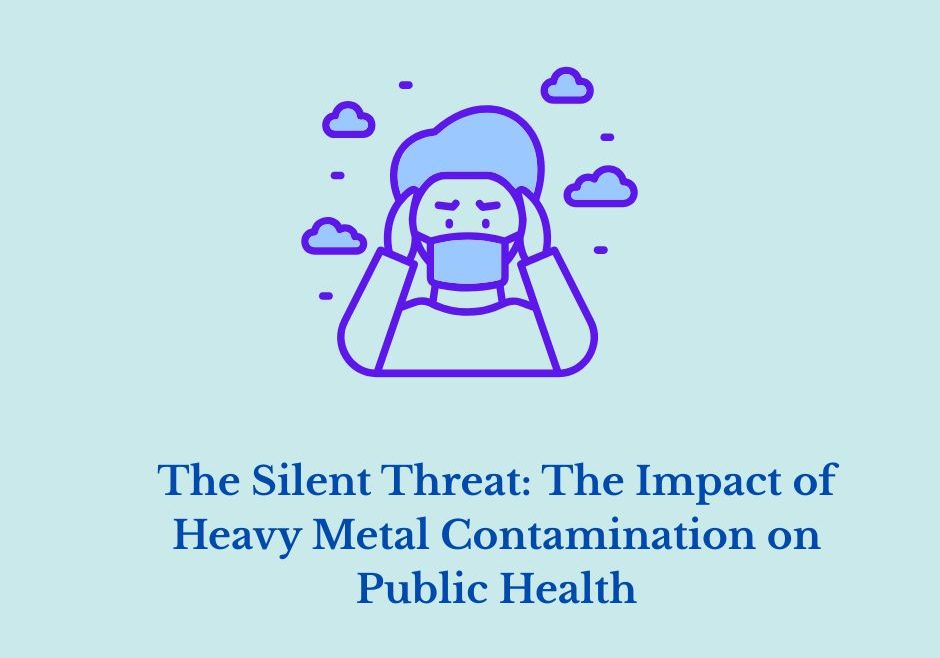Zarmina Khan
In our fast-paced world, it is easy to overlook the invisible threats around us. One such threat is heavy metal contamination, a problem that’s not just confined to industrial sites or polluted rivers but has slowly seeped into our everyday lives through the air we breathe, the water we drink, and the food we eat.
Heavy metals are naturally occurring elements with high atomic weights and densities at least five times greater than that of water. While some heavy metals like zinc, copper, and iron are essential for biological functions in trace amounts, others like lead, mercury, cadmium, and arsenic are toxic even at low concentrations. The increasing presence of heavy metals in the environment due to industrial and human activities has become a major public health concern.
Heavy metals can enter the environment through both natural processes and anthropogenic (human-related) activities. Major contributors to heavy metal pollution include
- Industrial Discharges Factories involved in mining, metal smelting, battery manufacturing, and electroplating often release heavy metals such as lead, cadmium, and chromium into water bodies, soil, and the air.
- Agricultural Activities: The use of chemical fertilizers, pesticides, and herbicides that contain heavy metals like arsenic and mercury can lead to soil and crop contamination.
- Urban Waste and Sewage: Improper disposal of electronic waste, paints, and batteries contributes to the leaching of heavy metals into landfills and eventually groundwater systems.
- Vehicle Emissions and Fossil Fuels: Combustion of gasoline and diesel fuels releases lead and other metals into the atmosphere, which settle on soil and water bodies through precipitation.
- Natural Sources: Erosion of mineral-rich rocks, volcanic eruptions, and forest fires also contribute to the natural release of heavy metals into the environment.
Unlike many other toxins, heavy metals do not break down over time. Instead, they accumulate in the body and in the environment, which makes even small exposures dangerous in the long run. The toxic effects of heavy metals on human health depend on the type of metal, exposure duration, and the level of concentration.
Here are some major health impacts.
- Lead (Pb): Lead exposure can cause neurological and behavioral disorders, particularly in children. It affects brain development, leading to learning disabilities, reduced IQ, and attention disorders. In adults, lead poisoning can cause kidney damage, hypertension, and reproductive issues.
- Mercury (Hg): Methylmercury, an organic form of mercury found in contaminated fish, affects the central nervous system. Symptoms include tremors, memory loss, and cognitive dysfunction. In pregnant women, mercury exposure can impair fetal brain development.
- Cadmium (Cd): Cadmium exposure, often through contaminated water or food, can lead to kidney damage, bone fragility (Itai-Itai disease), and an increased risk of cancer. It also affects the respiratory and cardiovascular systems.
- Arsenic (As): Chronic arsenic exposure, particularly through contaminated drinking water, is linked to skin lesions, cancers (skin, bladder, and lung), and cardiovascular diseases. Arsenic also disrupts cellular metabolism and DNA repair mechanisms.
- Chromium (Cr): Hexavalent chromium is a known carcinogen. It causes respiratory problems, skin irritation, and increases the risk of lung cancer upon prolonged inhalation or exposure.
In Bangladesh, one of the most alarming examples of heavy metal pollution comes from arsenic in groundwater. In the 1970s, millions of tube wells were drilled to provide clean drinking water, but many tapped into natural arsenic deposits. Today, around 78 million people are at risk of arsenic poisoning, which has been linked to skin lesions, various cancers, and cardiovascular diseases. The problem has become even more complicated as climate change increases flooding and alters groundwater chemistry, worsening the spread of arsenic contamination. In Nigeria’s Zamfara State, a tragic case unfolded in 2010 when unsafe gold mining operations led to widespread lead poisoning. At least 163 people died, most of them children, due to exposure to ore processed in residential areas.
In South Asia, industrial waste continues to pollute drinking water and food supplies. In the Indian city Lucknow, toxic metals such as chromium, cadmium, and arsenic have been found in soil and groundwater at concentrations hundreds of times above safe limits. These metals are linked to cancer, kidney damage, and hormonal disorders. In Pakistan, similar contamination has been found in industrial hubs like Lahore and Gujranwala, where untreated factory waste has polluted groundwater and agricultural fields, posing serious risks to human health and food safety. In 2015, Hong Kong faced a major scandal when lead was found in the tap water of public housing. It turned out to be caused by illegal plumbing work, leading to public outrage and urgent government action to test and replace pipes.
These real-world examples show that heavy metal contamination is a global issue. The health consequences are predominantly severe for children, pregnant women, and low-income communities who have limited access to healthcare or information.
Governments must implement stricter environmental regulations, industries must adopt cleaner and safer technologies, and public education campaigns must raise awareness about the risks and prevention strategies. By taking collective action, we can reduce exposure, clean up contaminated sites, and protect future generations from the long-lasting effects of heavy metal pollution.




